A front hair grab is a highly effective technique used by bullies and abusive Dark Hearts to intimidate their insecure victims. The attacked person feels they have no way to fight back because of a history of giving in or the attacker’s size seems insurmountable. As for attackers, a hair grab makes them feel powerful because it says, “I’m in control” or “I have ‘a handle’ on this person.”
What most attackers don’t know is how vulnerable they make themselves with a hair grab. With one arm up high, the attacker’s body becomes vulnerable to kicks and punches. (Oh the things you can do to an exposed rib cage!)
But there’s also one technique that pits most of your body weight against an attacker’s wrist, so their size doesn’t matter! Take a moment right now to see how far back you can make one hand bend backward over your forearm. I’m flexible, and I can’t hardly get it the lower part of my hand to bend beyond a 90 degree angle. Imagine the pain of abruptly forcing that wrist further than it wants to go.
Wait. You don’t have to imagine it. Just watch the video. That’s real pain happening.
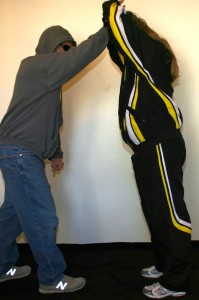
Both of my hands smash downward one at at time onto attackers hand, holding his hand firmly in place.
Here’s how to to it:
- One hand, then the other smashes the attacker’s grabbing hand onto your head — do not interlock fingers (SEE photos at bottom of post)
This does two things: stops the pain of the hair pulling and traps the attacker’s hand onto your head in a way that will lock the wrist into place for the next move. - Strong side foot slides straight back – keep hand smashed to your head!
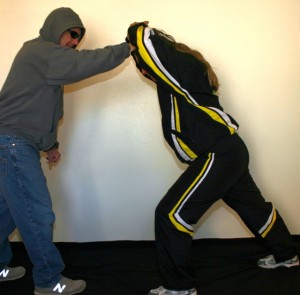
Strong leg (which is right leg for me) slides backwards.
This is a set up move only. It doesn’t cause pain or better trap the attacker’s hand. Remember when Indiana Jones takes out his bull whip and first draws the handle back behind his head in anticipation of the whipping motion? Same thing here.
- Instantly (as fast as the “choo” part of an “ahh…choo” sneeze) follow up the foot slide with a bend forward at waist as head and chin tuck down until you can see your back foot — keep hand smashed to your head!
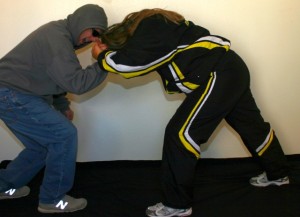
With his hand firmly smashed onto my head, I bend at waist and take my chin closer to my chest until I can see my back foot.
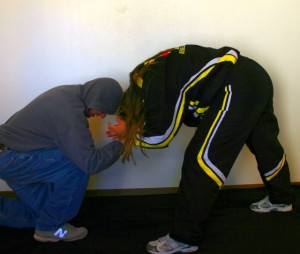
With pain at maximum and attacker on knees, I release his grabbing hand.
This is the part where Indiana Jones whips his bull whip forward. Your body motion and hand trap will torque the attacker’s trapped wrist backward into such pain that he will think it’s breaking and ripping inside.
To avoid the pain, most attackers will – without thinking — drop abruptly and painfully to one knee, maybe both. If you are lucky, the knee will hit so hard the attacker will be hurting now in two places.
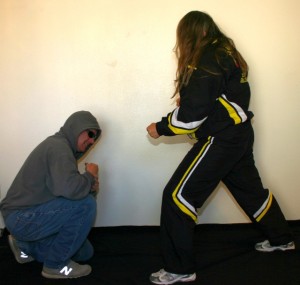
I'm now ready to run and free myself from the attack.
- Release the hand and run to safety … or … ahem … otherwise deal with the situation.
About practice:
To work, the entire release technique should take less than a second to perform (or the attacker will counter before you can make it work effectively). This release from front hair grab self defense technique requires a partner to get the full effect. Also recommended are: a doctor’s OK to exercise with abrupt moves, good balance, and supervision by a trained instructor.
NOTE: Realize the training partner who is playing the attacker will feel like their wrist is breaking, so two things will happen: 1) you could hurt each other by being too gung-ho and trying too hard and too fast without sensible control and without initial slow-motion practice, or 2) you two will be so timid about the pain, you’ll use too little speed and power for effective practice. Thus the need for a trained instructor to help.
Hey, I can only do so much from this end of things!
Some things that will make the self defense move ineffective are:
- Wrong timing – it must be one fast, smooth, and flowing action to work
- Unsure balance – it won’t help much if the step and head motion make you lose your balance
- Incorrect posture – many students who try this for the first time don’t step deep enough, step too deeply, or stick their butt out too much. The idea is to set up and whip forward, not stick out backwards
- Failure to take chin down to chest and look toward the back foot — this is the key move to make it work
- Bad hand placement — the fingers must not interlace and the wrist of the attacker must be free to bend.
The photos below show proper hand positions:
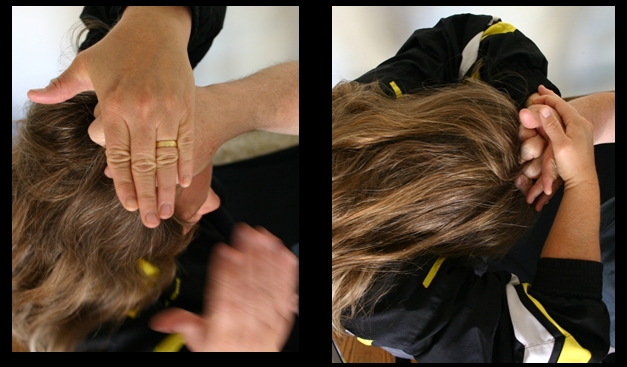
Smash attacker’s hand to your head with one hand, then the other — both hands firmly hold down the attacker’s hand to maintain control. When foot goes back and torso bends at waist, (see photos above), the chin tucks and head drops until you can see your back foot, thus creating torque and pain in the attacker’s wrist.
Any question or comments? Please feel free to leave them below.
—
This is a small portion of what I will be writing about regarding this subject and on this site. I hope you subscribe or return often to discover more about basic self defense moves.
Thank you for visiting and learning about self defense.
If you think others can benefit, please pass it on!
Comments on this entry are closed.
Hey you! This is very similar to what I was talking about. The whole non violent thing is not without pain…it’s just less violent than punching someone in the face. We had to have all of these moves used on us in class so we were more aware of the sensations the person being restrained was experiencing. I have to say that team control and the bite release are some of the most painful restraint and self preservation techniques I’ve ever felt. That’s the whole point of it…right? attacker feels some pain to make them stop what they’re doing. This is very good training though. You make it pretty easy to learn. High fives to you! I love ya!
Very well written Lori. Good clear images and a video to boot (is there some way of getting the video to replay without refreshing the page?)
In Aikido there are a lot of wrist lock techniques, so I can testify to the kind of pain this technique will have on the attacker when executed properly.
As Cat says, the non-violent part doesn’t translate into no pain. The pain is there to do one thing; takes the attacker’s mind, snapping him out of his intentions. As we are so fond of saying in Aikido; lead the mind and you can lead the body.
Hi Cat,
Thank you for the thumbs up on how it’s done and the comparison to institutional restraints. Pain is an amazing motivator.
Hi Marc,
Thank you, Marc. I’m new to video on blog tech, so my husband and I are trying to find the best way to make it work. Until then, sorry!
I’ve had some minor Aikido training, but mainly small circle jujitsu and grappling, and yes, the pain is amazingly overwhelming and will indeed lead the body!
Lori,
This is really cool. The pictures and your detailed description made me want to practice this. I got my boyfriend, who’s a little over six feet tall to grab my hair. I did what you said and even doing it slowly, he said that it hurt. Both of us could see how this would work.
However, if I want to keep my boyfriend around, I’ll probably have to find someone else to practice with:~)
Hi Sara,
Glad you found it effective and easy to learn!
After many years of martial arts instructing, I can say guys’ wrists tend to be less flexible than women’s. This means it takes even less torque to create pain. And yes, it can be tough to find someone to practice with who is willing to endure pain as well to help you both become more able to defend yourselves.
THANK YOU! I’ve been looking forward to this post for weeks! (I think I’ve managed to tweet it from my end.) As soon as I press submit, I’m going to start practising with my daughter.
Hi Janice,
Let me know how it goes!
Model, teach, and practice. Got it. This post is empowering and may I say, “You are a warrior mamsita”. Thanks for teaching us how to stay safe and refrain from being victims.
Hi Cindy,
You’re welcome, and thank you for the empowering description!
ACK! My browser is telling me I don’t have the right plug in installed to play the video! RATS!!!
However, the photos are very illustrative. I absolutely ADORE how quickly this can reverse the tables on a “powerful” attacker. Knowing what to do and how to do it can take an attacker from “power” to “panic” in an instant!!!
THANKS!!!
Hi Kathy,
If you can play .avi on your computer, I can sent video download via you listed email address.
Turning the tables, negating power, and controlling the mindset of the attacker is why self defense is easier than most people think. And from your tone, I can see you caught on to just how fun and empowering this can be!
What I think is great about this is how the movement doesn’t actually use pain for compliance (which is great, since you can’t depend on pain for results, e.g. attacker on drugs, tolerance, etc); it’s mechanical compliance. The attacker moves because the technique locks or breaks the structure of their wrist/arm/shoulder/body, creating a lever.
That being said, I’d much rather pivot to break the hold (the two persons’ elbows or forearms naturally meet to again lock or break the wrist/arm/shoulder/body), that way I remain standing rather than bending over and compromising my own structure. Less stress on my back as well.
Different strokes for different folks, maybe.
Besides, statistics show that it’s not really how you fight back, only that you fight back at all, that doubles your chances of survival; so good on you for putting the site up, Lori.
Hi Surgere,
Thank you for your comment and blog visit.
There are many ways to deal with a hair grab, including not being there when it is first initiated — my personal favorite 🙂 — and I hope to cover more of them in the future. Until then, if you care to submit a guest post with photos on the pivot move, I’d consider publishing it.
What if you are grabbed by the hair from behind?
Hi Anna,
That’s a more complicated, but similar move I will have to show via video. BUT backward foot stomps, backward elbows, and rapid, repeated hammer fists to the attacker’s groin are some things you can do, too. Remember, he will have one hand occupied, while you have every weapon available to you.
What if they have both hands on your hair?
Hi Louella,
Apply the technique to one of the hands. Also, if both hands are on your head, then the attacker’s body is open to kicks, knees, and other strikes.